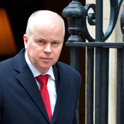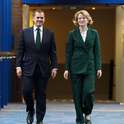Boris Johnson’s pre-conference posturing over his “personal vision” for Brexit looked shambling to the country. He pre-empted the prime minister’s speech in Florence by setting his own criteria for the negotiations in a 4,000-word Telegraph essay, ran into resentment and appeared to back down—before resurfacing on the eve of the Tory get-together in Manchester muttering about red lines again. An understandably annoyed Theresa May declined to be drawn on his future, and Britain saw its foreign secretary exposed as a mopped-topped chancer.
There was, however, a parallel world in which Johnson had proved himself to be a No. 10-ready patriot—the world of Conservative activists. A YouGov survey of members found him edging a leadership run-off against David Davis, by 46 to 39 per cent, and trouncing the more liberal Amber Rudd 57-33. Such intra-party polls have proved accurate before, notably in spotting the rise of longshot Jeremy Corbyn among Labour’s rank and file. The bookies took note and, however daft Johnson looked to most voters, made him the new favourite to replace May.
There is no mystery about why the Conservative base might be out of kilter with the country. The members are self-selecting, ageing and strikingly thin on the ground. The Tory campaigner, John Strafford, recently told journalist David Hencke that membership was freefalling towards 100,000, down from one published figure of 150,000 in 2013. Where constituencies such as Churchill’s Woodford boasted membership of well over 10,000 in the 1950s, today, Strafford suggests, in 300 seats, membership is 100 or less.
A country with little taste for active involvement in Conservative politics is indifferent to the withering of the voluntary party—but one thing could soon change that. With May badly weakened by her misfiring election, and even more vulnerable after her faltering Manchester speech, the stage is set for the thinned ranks of members to pick the country’s next leader. Nothing remotely like that has ever happened before.
"Though rarer than ever, Conservative members will likely soon have more power than ever before"Since the monarch finally lost all control over the pick in the early 19th century, every premier has either won an election in the country, or else emerged as, in effect, the choice of the MPs who represent it. When a PM goes, then, formally speaking, the Palace summons a replacement; but in practice and in sacrosanct convention, it calls on whoever is best-placed to command a Commons majority. In the distant past, this it established through rather mysterious consultation with the “men in grey suits” deemed to know the backbench mood. But in the 1960s, the Tories copied Labour and moved to a formal ballot of MPs. For a generation, that was the mechanism: James Callaghan replaced Harold Wilson through one such ballot in 1976; through another, in 1990, John Major took over from Margaret Thatcher.
Labour first gave members some say over the leadership in 1981; the Tories followed suit the best part of two decades later under William Hague. But neither party has ever used their internal democracy to fill No. 10. The last two mid-term changes in government, rather than opposition, were accomplished by parliamentarians closing ranks. By 2007, Gordon Brown had made himself seem so inevitable as Tony Blair’s heir, that nine Labour MPs in 10 nominated him, leaving nobody else with the numbers to run. In 2016, May watched and waited as a gamut of wannabes imploded—including Johnson, Michael Gove and finally the obscure Andrea Leadsom, who eventually folded after personally slighting May for not having children. May was then, in effect, crowned by acclamation. Mainstream MPs breathed an almighty sigh of relief, because some had feared that, in the heady wake of the referendum, the members could have been tempted by Leadsom, the wildly unready Brexit hardliner, over the Remain-voting May.
That will remain a “what if?” but, in opposition, members have often shown that they can’t be relied on to follow MPs: Ken Clarke was running ahead of Iain Duncan Smith among parliamentarians in 2001, but in the final party ballot he went down by over 20 points. And on the Labour side, Corbyn has more recently notched up overwhelming majorities of around 60 per cent, despite being mistrusted by 90 per cent of his MPs.
Tory MPs do, it is true, still get to whittle down candidates to the final two, just as Labour MPs still provide nominations. If, for example, the MPs tire of Johnson’s naked ambition, they might head him off at the pass. But hopelessly divided on Brexit, they will struggle to co-ordinate much.
Though rarer than ever, Conservative members will likely soon have more power than ever before. What they will use it for is less certain. Activists don’t always lurch to the extremes—in 2005, two Tory members in three went for the modernising smoothie, David Cameron; in 1988, just seven years after internal democracy was supposed to cement the Left’s grip on Labour, its electoral college rejected Tony Benn’s run against Neil Kinnock by 89 to 11. And on occasion, as Corbyn supporters can argue after June’s close election, members might be ahead of MPs in reading the country.
But when members are as few as in today’s Tory Party, nothing can be assumed about the result—or the country’s reaction to it. Entrusting the choice of PM to a card-carrying cadre is an experiment we’ve not run before. It won’t be long—I suspect—before we know how it goes down. I, for one, will be listening out for a clamour for an early election.













